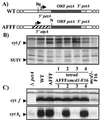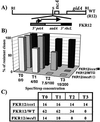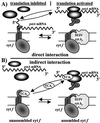Translation of cytochrome f is autoregulated through the 5' untranslated region of petA mRNA in Chlamydomonas chloroplasts
- PMID: 9539745
- PMCID: PMC22497
- DOI: 10.1073/pnas.95.8.4380
Translation of cytochrome f is autoregulated through the 5' untranslated region of petA mRNA in Chlamydomonas chloroplasts
Abstract
A process that we refer to as control by epistasy of synthesis (CES process) occurs during chloroplast protein biogenesis in Chlamydomonas reinhardtii: the synthesis of some chloroplast-encoded subunits, the CES subunits, is strongly attenuated when some other subunits from the same complex, the dominant subunits, are missing. Herein we investigate the molecular basis of the CES process for the biogenesis of the cytochrome b6f complex and show that negative autoregulation of cytochrome f translation occurs in the absence of other complex subunits. This autoregulation is mediated by an interaction, either direct or indirect, between the 5' untranslated region of petA mRNA, which encodes cytochrome f, and the C-terminal domain of the unassembled protein. This model for the regulation of cytochrome f translation explains both the decreased rate of cytochrome f synthesis in vivo in the absence of its assembly partners and its increase in synthesis when significant accumulation of the C-terminal domain of the protein is prevented. When expressed from a chimeric mRNA containing the atpA 5' untranslated region, cytochrome f no longer showed an assembly-dependent regulation of translation. Conversely, the level of antibiotic resistance conferred by a chimeric petA-aadA-rbcL gene was shown to depend on the state of assembly of cytochrome b6f complexes and on the accumulation of the C-terminal domain of cytochrome f. We discuss the possible ubiquity of the CES process in organellar protein biogenesis.
Figures




Similar articles
-
The nucleus-encoded trans-acting factor MCA1 plays a critical role in the regulation of cytochrome f synthesis in Chlamydomonas chloroplasts.Plant Cell. 2011 Jan;23(1):333-49. doi: 10.1105/tpc.110.078170. Epub 2011 Jan 7. Plant Cell. 2011. PMID: 21216944 Free PMC article.
-
Assembly-controlled regulation of chloroplast gene translation.Biochem Soc Trans. 2001 Aug;29(Pt 4):421-6. doi: 10.1042/bst0290421. Biochem Soc Trans. 2001. PMID: 11498001 Review.
-
TCA1, a single nuclear-encoded translational activator specific for petA mRNA in Chlamydomonas reinhardtii chloroplast.Genetics. 2001 Sep;159(1):119-32. doi: 10.1093/genetics/159.1.119. Genetics. 2001. PMID: 11560891 Free PMC article.
-
Cytochrome f translation in Chlamydomonas chloroplast is autoregulated by its carboxyl-terminal domain.Plant Cell. 2003 Jun;15(6):1443-54. doi: 10.1105/tpc.011692. Plant Cell. 2003. PMID: 12782735 Free PMC article.
-
Biogenesis of the electron-transfer complexes in Chlamydomonas reinhardtii.Biochem Soc Trans. 1996 Aug;24(3):733-8. doi: 10.1042/bst0240733. Biochem Soc Trans. 1996. PMID: 8878836 Review. No abstract available.
Cited by
-
Translational downregulation of RBCL is operative in the coordinated expression of Rubisco genes in senescent leaves in rice.J Exp Bot. 2013 Feb;64(4):1145-52. doi: 10.1093/jxb/ers398. Epub 2013 Jan 23. J Exp Bot. 2013. PMID: 23349140 Free PMC article.
-
Availability of Rubisco small subunit up-regulates the transcript levels of large subunit for stoichiometric assembly of its holoenzyme in rice.Plant Physiol. 2012 Sep;160(1):533-40. doi: 10.1104/pp.112.201459. Epub 2012 Jul 17. Plant Physiol. 2012. PMID: 22811433 Free PMC article.
-
A nuclear gene in maize required for the translation of the chloroplast atpB/E mRNA.Plant Cell. 1999 Sep;11(9):1709-16. doi: 10.1105/tpc.11.9.1709. Plant Cell. 1999. PMID: 10488237 Free PMC article.
-
Intercistronic expression elements (IEE) from the chloroplast of Chlamydomonas reinhardtii can be used for the expression of foreign genes in synthetic operons.Plant Mol Biol. 2018 Nov;98(4-5):303-317. doi: 10.1007/s11103-018-0776-z. Epub 2018 Sep 17. Plant Mol Biol. 2018. PMID: 30225747
-
Hosts for Hostile Protein Production: The Challenge of Recombinant Immunotoxin Expression.Biomedicines. 2019 May 17;7(2):38. doi: 10.3390/biomedicines7020038. Biomedicines. 2019. PMID: 31108917 Free PMC article. Review.
References
Publication types
MeSH terms
Substances
LinkOut - more resources
Full Text Sources

